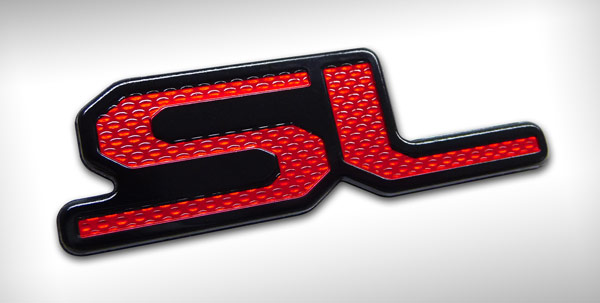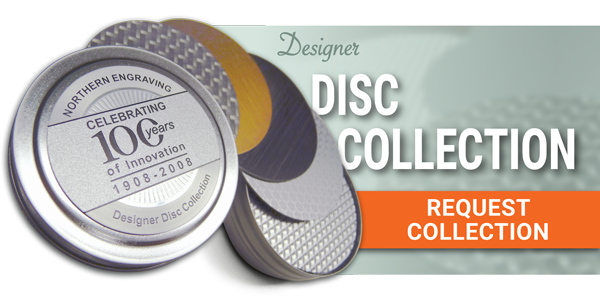How to Customize Patterns for Aluminum Badges using Color
Pattern Customization Using Color
Many times patterns on aluminum nameplates and trim are developed using silver background. It is so fun to see how customers take a pattern and customize it to suit their needs and design. One option to customize a pattern for product identification is to change the color. This article provides a look at what is needed to achieve attractive branding using a customized pattern.
1. How will the Pattern be used on your Aluminum Nameplate?
The first step is to figure out what you want the pattern to do for your brand. Is it being worked in as a background which will complement or contrast the product housing? Or perhaps you want to add some interest to a focal point of the nameplate or badge. This will help you when you are reviewing finish options. Background finishes typically follow a specific structure. Accent areas draw attention and can help to communicate a specific theme or feeling for the consumer.
2. Select Pattern Structure or Theme
Literally thousands of patterns have been developed for use as inspiration and talking points. The Surface Collection Gallery makes sorting through the options easy by selecting a structure or theme. When you have determined a reference pattern, take note of the finish ID so that your artwork file communicates your intent.
| Available structures include: | Theme options include: |
3. Define your Custom Color
Color direction is important so that the end result matches your design intent. PMS Colors are most common, but you can also specify custom color targets as well as gloss levels. Color can be defined as opaque, transparent or metallic. Each will affect the look of the pattern in different ways.
Pulling it Together
The image shown above is an aluminum badge which designates a specific model for motorcycle trim. It uses the dot pattern structure found on other aluminum trim on the vehicle and jazzes it up with a transparent red color. This achieves two things: Consistency in trim decoration and Draws attention to the specific product model that this aluminum badge represents.
Now you have reviewed the elements needed to customize a pattern, you are ready to incorporate direction into your aluminum nameplate design. Be sure that your artwork file calls out where the pattern should be located on your part, the finish ID for pattern reference and color direction.
What pattern would you like to customize for your next aluminum nameplate? Let's talk!
Subscribe to Nameplate Blog
- 3D (4)
- Adhesives (11)
- Aluminum (137)
- Aluminum In-mold (9)
- Aluminum Trim (41)
- Anodize (4)
- Appliance (14)
- Appliqué (7)
- Archive (43)
- Artwork Submission (4)
- Assembly (6)
- Automotive (37)
- Backlit (6)
- Boats (7)
- Brass (8)
- Brushed Aluminum (19)
- Carbon Fiber (2)
- Chrome Polyester (14)
- Classic (1)
- Coined (5)
- Color Development (26)
- Computers (13)
- Cosmetics (30)
- Custom Patterns (12)
- Customization (16)
- Customized Patterns on Aluminum (2)
- Debossing (13)
- Diamond Cut (22)
- Digital Printing (2)
- Domed Labels (46)
- ebook (4)
- Electronics (25)
- Embossing (60)
- Etched (21)
- Exterior (11)
- FAQ (30)
- Faux Finish (1)
- Faux Finishes (10)
- Favorite Nameplate (23)
- Flexible Labels (37)
- Furniture (12)
- Gauges (7)
- Gloss (4)
- Hang Tag (1)
- IDSA (1)
- In-mold Decoration (5)
- Individual Letters (13)
- Inlay (1)
- Key Fob (3)
- Labels (17)
- Large Vehicle (5)
- Laser Etch (2)
- Lithography (3)
- Match Box Cover (6)
- Materials and Processes (132)
- Mechanical Finishes (53)
- Medical Equipment (12)
- Metallic (9)
- Motorcycle (13)
- Nameplate (186)
- Nameplate Examples (59)
- Nameplate Tools (7)
- Outdoor Equipment (5)
- Overlay (8)
- Packaging (17)
- Patina Finish (3)
- Plastic (14)
- Plastic Trim (4)
- Point of Purchase (12)
- Polycarbonate (19)
- Process Color (19)
- Promotional Products (40)
- Prototypes (2)
- Recreational Vehicles (7)
- Resources (11)
- Safety Labels (2)
- Selective Patterns (10)
- Sill Plate (6)
- Sports Equipment (11)
- Stainless Steel (17)
- stock dies (10)
- Surfaces (4)
- Sustainability (1)
- Technical (1)
- Telecommunications (10)
- Testing (3)
- Texture (15)
- Top 10 (9)
- Woodgrain (2)








